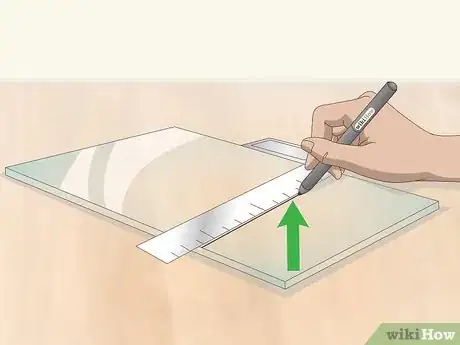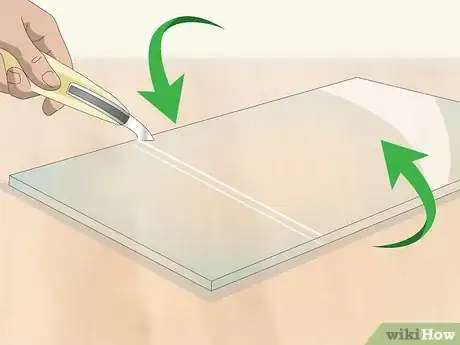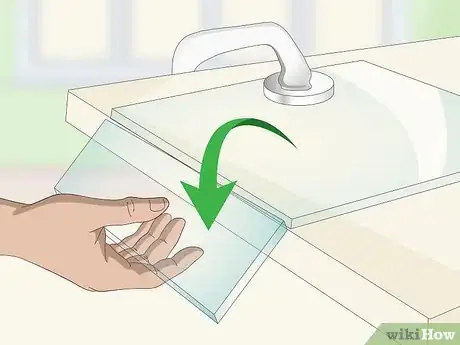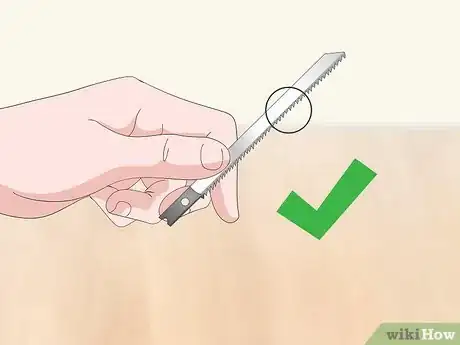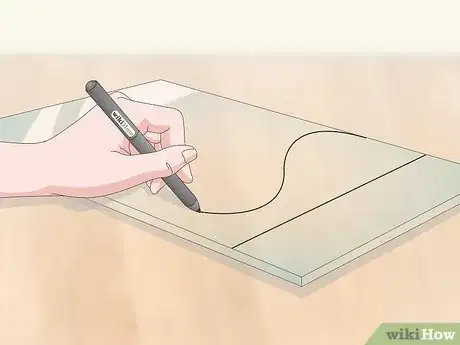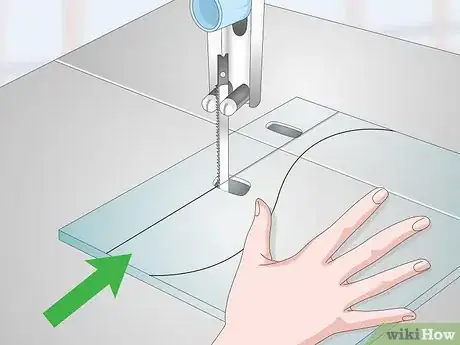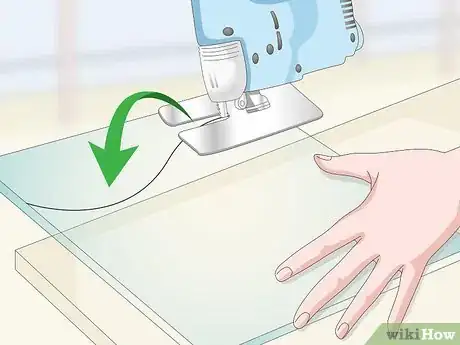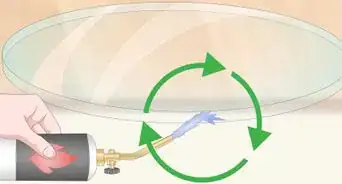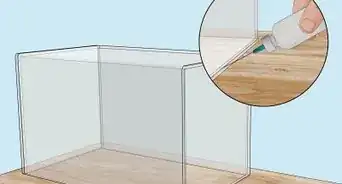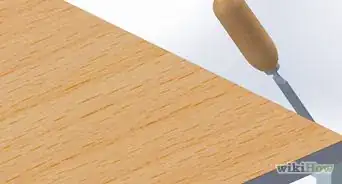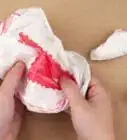This article was co-authored by wikiHow Staff. Our trained team of editors and researchers validate articles for accuracy and comprehensiveness. wikiHow's Content Management Team carefully monitors the work from our editorial staff to ensure that each article is backed by trusted research and meets our high quality standards.
There are 8 references cited in this article, which can be found at the bottom of the page.
wikiHow marks an article as reader-approved once it receives enough positive feedback. In this case, 85% of readers who voted found the article helpful, earning it our reader-approved status.
This article has been viewed 176,168 times.
Learn more...
If you're a do-it-yourself-er, you've likely needed to use acrylic sheeting in a project. Acrylic sheets are fairly simple to cut. If your sheet is relatively thin--less than 3⁄16 inch (0.48 cm)--you can use the scoring method. Otherwise, you'll need to use a saw to cut it. Put on safety glasses before doing any kind of cutting, and wear ear plugs if you use an electric saw.[1]
Steps
Cutting a Straight Line by Scoring the Acrylic
-
1Set the acrylic on a flat surface. To make it easier to work with, find a flat surface big enough to accommodate your plastic sheet. However, you can't use the floor, as you need an edge to break the acrylic over later.[2]
-
2Mark your line. Begin by deciding where you want to cut the acrylic. Measure it out, and use a ruler to make a straight line. You can mark the line with a permanent marker or grease pencil, or you can just use the ruler as a guide for your blade.[3]Advertisement
-
3Score the line in the acrylic with a plastic scoring blade. Using your ruler as a guide, run a plastic scoring blade along the cutting line, trying to make one continuous line with gentle, even pressure. Pull the blade towards you along the line. It's especially important to get a straight line on the first go-round, as that line guides your subsequent lines.[4]
-
4Deepen the cut using the scoring blade. Run the blade over the line several times until you have a substantial groove. Once you do, flip it over, and make a line along the backside that follows the line on the other side. Score it several times as well.[5]
-
5Break the acrylic sheet. Place the line you've scored directly along the edge of the table. Using clamps to hold the sheet to the table makes the process easier. Break the sheet at the scored line by pressing down on the outer edge in a quick motion. You can wrap your hand around one edge and use your body weight to push down.[6]
Sawing Acrylic
-
1Use a blade meant for acrylic. For plastic, you need a blade with a high tooth count. Look for a blade that says it's made for acrylic or plexiglass. You'll get a much cleaner cut with these blades.[7]
- You can use a regular blade, but the cut will be more jagged.
-
2Mark the cut. Before beginning, mark what you want to cut with a permanent marker. With a circular saw, table saw, or saber saw, you can cut a straight line. With a jigsaw, you can cut curves. Use a straight edge if necessary.[8]
- Placing masking tape over your cut line can help you make a cleaner edge with a jigsaw.
-
3Push the acrylic through a table saw for a straight cut. Start at one edge of the mark you made. Push the acrylic through the table saw at a steady pace, being sure to keep your fingers out of the way of the saw. Don't move too quickly, as you'll create a rougher edge, but don't go too slowly, as you can melt the plastic.[9]
-
4Cut a curved line with a jigsaw. Set up the acrylic glass on 2 beams so that you can cut through it with the jigsaw. Push the jigsaw from the outer edge towards your body along the line you made, so you can constantly keep your eye on the blade and the line. If you get stuck at an angle, pull the jigsaw out the way you came, and cut from the other edge.[10]
Sanding the Edges
-
1File down any sharp burrs with a metal file. Check for any large chunks that the saw or scoring method left behind on the edge. Use a metal file to smooth them out so they are even with the edge you cut.[11]
-
2Sand the edge 180-grit waterproof sandpaper. With the sandpaper on a sanding block, apply water to the sandpaper. Use enough to get the sandpaper thoroughly wet. Sand down the edge. Move to finer and finer sandpaper to refine the edge, ending up with 600-grit sandpaper.[12]
- Purchase waterproof sandpaper designed for plastic.
-
3Buff the edge. Attach a buffing edge to your electric drill. Rub the buffer with a polishing compound, and then buff down the edge until it is smooth and shiny. This step really refines the edge, but it is not absolutely necessary.[13]
- If you don't have a buffing edge, you can stop with fine sandpaper.
Community Q&A
-
QuestionI want to round the edges of 1/4" Plexiglas for a tabletop. Any suggestions?
 T. ChinsenTop AnswererMake the original cut as clean as possible. This will reduce the sanding time significantly. Start with rough paper ~180 grit and a foam sanding block. Sand until the edge is uniform and relatively smooth. Switch to fine, then finer paper (360 and 600 grit) to get a satin finish. When using 360 grit, start wet-sanding. With the foam block and sand paper, cup the edge to smooth it round.
T. ChinsenTop AnswererMake the original cut as clean as possible. This will reduce the sanding time significantly. Start with rough paper ~180 grit and a foam sanding block. Sand until the edge is uniform and relatively smooth. Switch to fine, then finer paper (360 and 600 grit) to get a satin finish. When using 360 grit, start wet-sanding. With the foam block and sand paper, cup the edge to smooth it round.
Things You'll Need
- Acrylic sheets
- Plastic scoring blade
- Ruler
- Permanent marker or grease pencil
- Jigsaw, optional
- Table saw, optional
- Metal file
- Waterproof sandpaper meant for plastic
- Drill, optional
- Buffing edge, optional
- Polishing compound, optional
References
- ↑ http://www.ultimatehandyman.co.uk/how-to/acrylic/cutting-acrylic
- ↑ https://www.bobvila.com/articles/how-to-cut-plexiglass/#.WehX5jBGnIU
- ↑ https://makezine.com/2015/10/29/skill-builder-acrylic/
- ↑ https://makezine.com/2015/10/29/skill-builder-acrylic/
- ↑ https://www.bobvila.com/articles/how-to-cut-plexiglass/#.WehX5jBGnIU
- ↑ https://www.bobvila.com/articles/how-to-cut-plexiglass/#.WehX5jBGnIU
- ↑ http://www.ultimatehandyman.co.uk/how-to/acrylic/cutting-acrylic
- ↑ https://www.bobvila.com/articles/how-to-cut-plexiglass/#.WehX5jBGnIU
- ↑ https://www.hunker.com/13402629/how-to-cut-acrylic-sheet
About This Article
To cut acrylic sheets, start by marking the line you want to cut using a ruler and a permanent marker. Then, score the line using a plastic scoring blade, using the ruler as a guide so your line is straight. Once you've scored the initial line, go over it a few times with the blade until a groove forms. Next, repeat on the opposite side of the acrylic sheet over the same line. Finally, place the line you scored over the edge of a table and press down on the part of the acrylic that's hanging off of the table to break it off. To learn how to cut acrylic by sawing it, scroll down!

